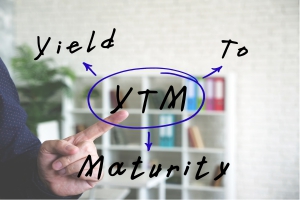
When Astha got her first hike, at the age of 25, she decided to start investing. As a senior account executive at a large media company, she had her future mapped out – after attaining strong experience in the field, she wanted to start her own firm and build a roster of niche clients. For the same, she wanted a seed fund ready, and this was her motive when she began considering different types of mutual fund schemes. As she read about the benefits of mutual funds and bond investment, she was stuck by an important question – what did yield to maturity mean and how could she use this metric to build an optimal portfolio?
What is Yield to Maturity?
The term Yield to Maturity or YTM refers to the internal rate of return offered by your bond investment. For the formula to offer a proper result, investors must remain invested till maturity and reinvest all the proceeds, at a constant rate. In simpler terms, YTM can be considered similar to the current yield or the return investors expect to receive, upon holding the security for a period of one year. So, what is the yield on a security? Yield is defined as the measure of cash flow offered by an investment, over a period of time, expressed in the form of a percentage. To arrive at the yield on your investment, you have to consider all the dividends payouts or interest that you receive from the investment, during its tenure.
How does YTM work?
Astha found the concept quite interesting, since she did not know that she would also receive dividends or interest on her investment, in addition to the growth in value. If she invested in stocks, her yield would be calculated as the return earned on the dividend and, if she went the bond route, the interest, or the coupon rate, would act as the yield on her investment. In case of bonds, she would also have to consider the discount rate on the coupon, which would help her arrive at the actual yield to maturity that she could expect to earn.
Formula to calculate YTM
To calculate the yield she would receive on her bond investments, Astha used the following formula –
YTM equals the nth root of the bond’s face value, divided by its current value, and then subtracted by 1. In this scenario, when the bond is priced at par, meaning there is no discounting on the bond’s price, then the coupon rate and the bond’s actual interest rate would be equal. However, when the bond is being traded at a premium, then the coupon rate would be higher than the interest rate you receive on your investment. Conversely, if you purchase the bond at a discount, then the interest you earn would be higher than the pre-decided coupon rate. When you have these details in place, you can also calculate the YTM like Astha did.
Why you should use YTM
One of the most important uses of YTM is that it helps you determine whether a particular bond is a good investment or not. You can also use YTM to calculate the potential returns on different bonds, thus making it easier for you to opt for the best choice. This does not mean that the method has no limitations. YTM does not calculate the taxes you need to pay on your returns, and neither does it ensure a no-default clause from the bond’s issuer. Since many of the factors in YTM are approximates, investors cannot depend on them on an absolute basis.
If you are keen on investing in bonds, it is a good idea to check the YTM before investing, as this will help you choose a bond with a high rate of return.
An investor education initiative by Edelweiss Mutual Fund
All Mutual Fund Investors have to go through a one-time KYC process. Investors should deal only with Registered Mutual Fund (RMF). For more info on KYC, RMF and procedure to lodge/redress any complaints, visit - https://www.edelweissmf.com/kyc-norms
MUTUAL FUND INVESTMENTS ARE SUBJECT TO MARKET RISKS. READ ALL SCHEME-RELATED DOCUMENTS CAREFULLY
Trending Articles
MUTUAL FUND INVESTMENTS ARE SUBJECT TO MARKET RISKS, READ ALL SCHEME RELATED DOCUMENTS CAREFULLY.















